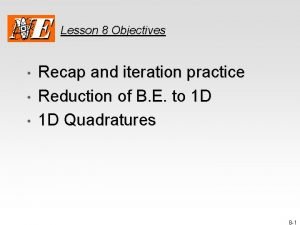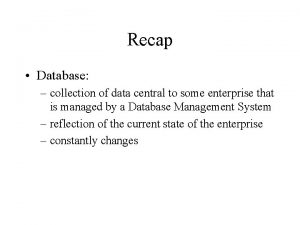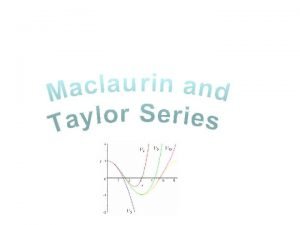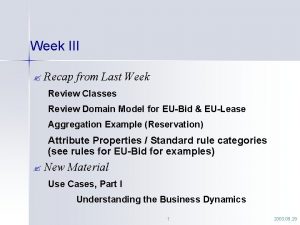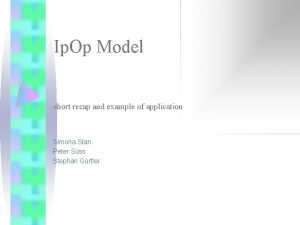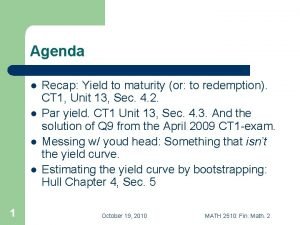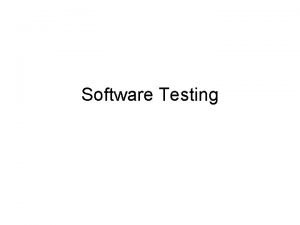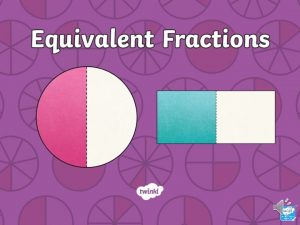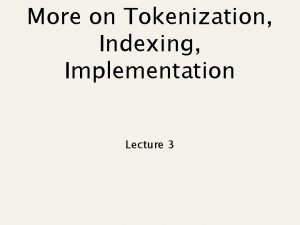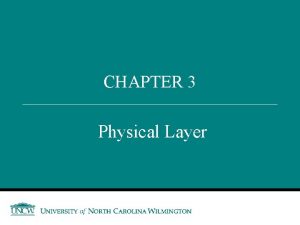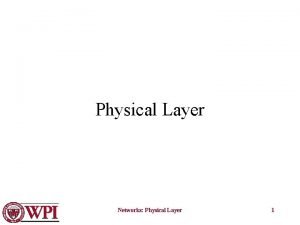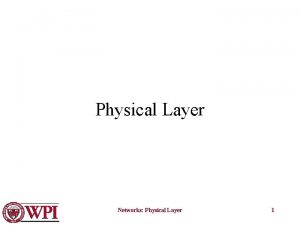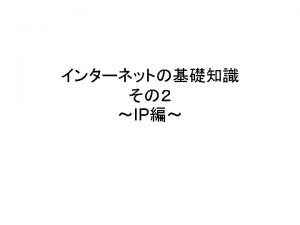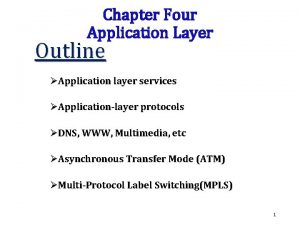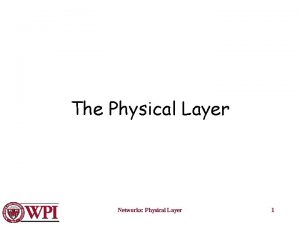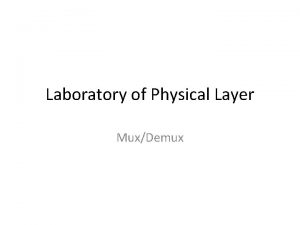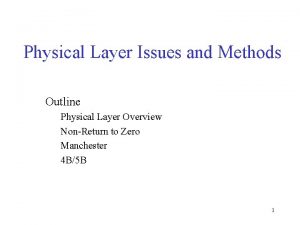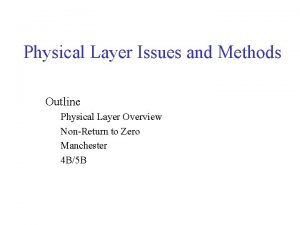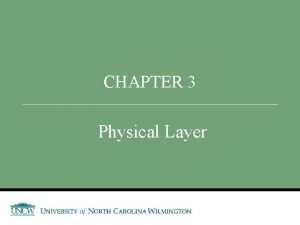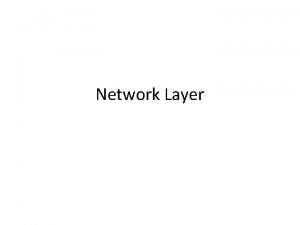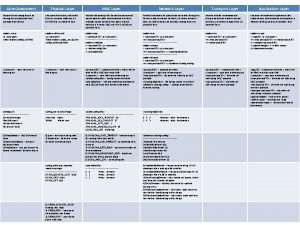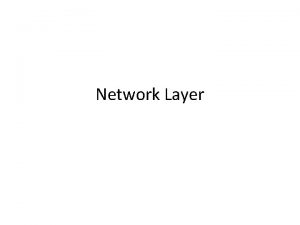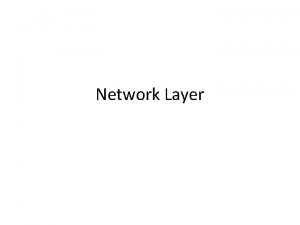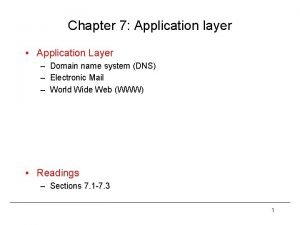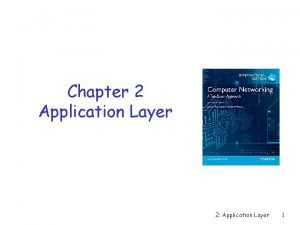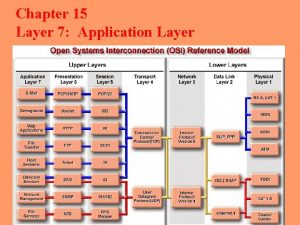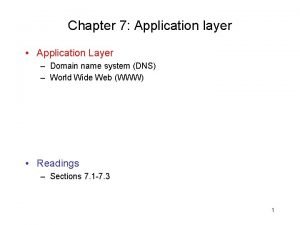CHAPTER 3 Physical Layer Outline Recap 2 Application































- Slides: 31

CHAPTER 3 Physical Layer

Outline Recap 2. Application Layer 2. 1 Hardware 2. 2 Application Architecture (Software) 2. 3 Web 2. 4 Email Outline 3. Physical Layer 3. 1 3. 2 3. 3 3. 4 3. 5 Circuits Media Digital Transmission (Digital Data) Analog Transmission (Digital Data) Digital Transmission (Analog Data) 2

Network Layers Computer 1 Computer 2 3

Acronyms • FDM – Frequency Division Multiplexing • TDM – Time Division Multiplexing 4

3 Physical Layer - Overview Includes network hardware and circuits Network Layer Data Link Layer Physical Layer Types of Circuits § Physical circuits connect devices & include actual wires § Logical circuits refer to the transmission characteristics of the circuit § Physical and logical circuits may be the same or different. For example, in multiplexing, one physical wire may carry several logical circuits. 5

3. 1. 2 Circuit Configurations Basic physical layout of the circuit Configuration types: § Point-to-Point Configuration § Multipoint Configuration 6

3. 1. 2. 1 Point-to-Point Configuration 7

3. 1. 2. 2 Multipoint Configuration 8

3. 1. 2 Data Flow (Transmission) How does data flow through the circuit Configuration types: § Simplex § Half-Duplex § Full-Duplex 9

3. 1. 2 Data Flow (Transmission) 10

3. 1. 3 Data Flow (Transmission) – Multiplexing Combines many low speed circuits into one high speed transmission Categories of multiplexing 11

3. 1. 3 Frequency Division Multiplexing Makes a number of smaller channels from a larger frequency band by dividing the circuit “horizontally” Host computer FDM circuit Four terminals 12

3. 1. 3 Time Division Multiplexing Dividing the circuit “vertically” • TDM allows terminals to send data by taking turns 13

3. 1. 4 Inverse Multiplexing Combines a number of low speed circuits to create a single high speed circuit on the opposite ends Why would companies choose to do this? 14

Inverse Multiplexing (IMUX) Shares the load by sending data over two or more lines 15

Digital Subscriber Line (DSL) Became popular as a way to increase data rates in the local loop. 16

3. 2 Media Physical matter that carries the transmission Types: • Guided Media • Radiated (Unguided) Media 17

3. 2. 1. 1 Guided: Twisted Pair (TP) Wires Commonly used for telephones and LANs Reduced electromagnetic interference TP cables have a number of pairs of wires Price: Speed: Distance: Common Use: 18

3. 2. 1. 1 Guided: Twisted Pair (TP) Wires (CAT 5 e) 19

3. 2. 1. 1 Guided: Comparison of Cables 20

3. 2. 1. 2 Guided: Coaxial Cable • Less prone to interference than TP due to shield • More expensive than TP, thus quickly disappearing Price: Speed: Distance: Common Use: 21

3. 2. 1. 2 Guided: Problems with Copper 22

3. 2. 1. 3 Guided: Fiber Optic Cable • Light created by an LED (light-emitting diode) or laser is sent down a thin glass or plastic fiber • Has extremely high capacity, ideal for broadband • Works well under harsh environments Price: Speed: Distance: Common Use: 23

3. 2. 1. 3 Guided: Fiber Optic Cable Fiber optic cable structure (from center): § Core (v. small, 5 -50 microns, ~ the size of a single hair) § Cladding, which reflects the signal § Protective outer jacket How they are made: http: //www. youtube. com/watch? v=ll. I 8 Mf_fa. Vo Communication: http: //www. ehow. com/video_4951202_optical-fiberwork_. html 24

Types of Optical Fiber Multimode (about 50 micron core) § Earliest fiber-optic systems § Signal spreads out over short distances (up to ~500 m) § Inexpensive Graded index multimode § Reduces the spreading problem by changing the refractive properties of the fiber to refocus the signal § Can be used over distances of up to about 1000 meters Single mode (about 5 micron core) § Transmits a single direct beam through the cable § Signal can be sent over many miles without spreading § Expensive (requires lasers; difficult to manufacture) 25

Optical Fiber 26

3. 2. 1. 3 Guided: Which is faster – Fiber or Copper? Fiber transmits via light – does that mean it is faster than copper b/c it travels at the speed of light? Data Carrying Capacity What should companies use? 3 - 27

3. 2. 2. 1 Wireless (Unguided) – WLAN (Radio) Wireless transmission of electrical waves through air Each device has a radio transceiver with a specific frequency Includes § § § Speed: Distance 28

3. 2. 2. 2 Wireless Media - Microwave High frequency form of radio communications Performs same functions as cables Speed: Distance: 29

3. 2. 2. 3 Wireless Media - Satellite Special form of microwave communications Signals travel at speed of light, yet long propagation delay due to great distance between ground station and satellite Speed: Distance: 30

3. 2 Factors Used in Media Selection Type of network Cost Transmission distance Security Error rates Transmission speeds 31
 Fig 19
Fig 19 Phases of deglutition
Phases of deglutition Secure socket layer and transport layer security
Secure socket layer and transport layer security Layer 6 presentation layer
Layer 6 presentation layer Secure socket layer and transport layer security
Secure socket layer and transport layer security Secure socket layer and transport layer security
Secure socket layer and transport layer security Secure socket layer and transport layer security
Secure socket layer and transport layer security Layer 2 e layer 3
Layer 2 e layer 3 Layer-by-layer assembly
Layer-by-layer assembly Layer 2 vs layer 3 bitstream
Layer 2 vs layer 3 bitstream The shawshank redemption summary
The shawshank redemption summary The great gatsby chapters 8-9 summary
The great gatsby chapters 8-9 summary What is price matching
What is price matching What is the purpose of an iteration recap?
What is the purpose of an iteration recap? Recap intensity clipping
Recap intensity clipping 60 minutes recap
60 minutes recap Recap database
Recap database Bracket power rule
Bracket power rule Introduction for recap
Introduction for recap Recap introduction
Recap introduction Recap from last week
Recap from last week The crucible discussion questions act 1
The crucible discussion questions act 1 The crucible act 1 recap
The crucible act 1 recap Logbook recap example
Logbook recap example Ytm recap
Ytm recap Black box recap
Black box recap Fractions recap
Fractions recap Recap
Recap Recap coordinate system
Recap coordinate system Recap indexing scans
Recap indexing scans Lets recap
Lets recap Recap poster
Recap poster













